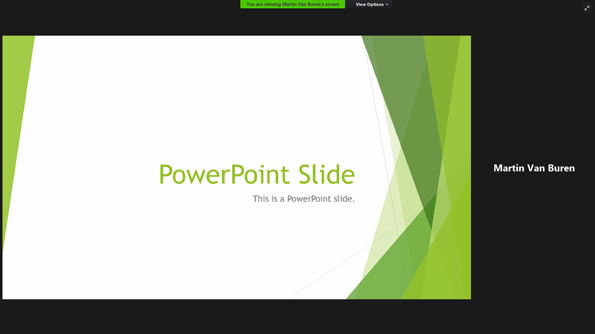
I don't usually call out webinar platform vendors by name. But I'm making an exception this time for two reasons. First, because a recent screen layout redesign implemented by Zoom makes the webinar attendee experience radically worse. And, second, because Zoom is so big now, with so many users, that a change like this is inexcusable and should be called out. No more free passes for Zoom.
Before I explain exactly what Zoom did and why it was such a bad decision, I'll explain the inherent problem that likely led to this. Zoom is one of many webinar platforms that didn't start out as webinar platforms or were never primarily meant to be webinar platforms. Instead, the core business of Zoom and many others is online peer-to-peer meeting and collaborating. This is what most people think of when they think of Zoom. During the pandemic, Zoom's userbase grew exponentially as people were forced to stay home and meet online. Platforms like Zoom became the only way for colleagues, friends, and family to meet "face-to-face." But you know all that already.
What you may not know is that there's also another version of Zoom. It's a different subscription plan that costs more than the free or moderately-priced "Meetings" version of Zoom. This "Webinars" version of Zoom enables users to host formal webinars and other events for large external audiences. It includes special functionality required by webinar organizers and offers webinar hosts much tighter control over the attendee experience.
Usually, the "webinar" versions of online meeting platforms were built on top of or later added on to the original "meeting" versions of the software. In some ways, this is a good thing. If you're already familiar with Zoom Meetings, then Zoom Webinars will look and work in much the same way. On the other hand, there are significant use case differences between "meetings" and "webinars." What's good for an informal meeting between a few co-workers isn't necessarily good for a formal webinar event with hundreds of attendees. If a platform vendor arbitrarily applies the same change or update across all versions of its software with no consideration given to use cases, they can end up making their product worse, not better. This is what has apparently happened with Zoom.
When using live webcam video with Zoom Webinars, webinar hosts have a range of screen layout options they can set for attendees. In fact, this is one of the strengths of Zoom Webinars. It's great that hosts have the flexibility to select a screen layout that works best for the format of their particular webinar and the ability to prescribe a consistent webinar viewing experience for all attendees. For example, if a webinar host wants the audience to see live video side-by-side with presentation slides, no problem. If the host wants video to appear at the top of the screen, above the slides, that's possible too. The host can also dictate whether attendees can see all speakers who are currently on camera or only the current speaker.
In the past, when none of the webinar speakers or presenters were on camera, then the audience saw only the visual content currently being shared, like a presentation slide. It was quite elegant, actually. When the last speaker turned off their camera, the video window would simply melt away, with the presentation slide dynamically increasing in size to fill the space.
That doesn't happen anymore. Now, regardless of whether any webinar speakers are on camera or not, the audience always sees a "video" window on the screen. In the absence of any live video, it appears as an empty black box with the name of the person currently speaking. That's fine, in and of itself. But it's completely unnecessary. And it's a waste of screen space. And it's distracting.

If Zoom Webinars had always worked like that, fine again. But this is a new "update." An "update" is supposed to make a product better, not worse. Looking through Zoom's software release notes, I see why the change was made. It was made to fix a trivial matter with the Zoom Meetings user interface. The minor problem they wanted to fix really had nothing to do with screen layout or user experience, per se, but the solution they implemented has had much more of an impact on both of those things than it rightfully should have.
Even so, if the unintended consequences of this new update ended up affecting Zoom Meetings only, fine for a third time. An informal meeting with a small group of people isn't meant to have the polished, professional look of a formal webinar event. Nobody would care about a superfluous "video" window with a person's name in it that served no apparent purpose. But since Zoom Webinars was built on top of Zoom Meetings, the change automatically carried over to the webinar version of the software. My assumption is that nobody at Zoom thought this would be a problem, because they disregarded the significant use case differences between meetings and webinars. One of the many differences is that, with webinars, aesthetics matter.
Or, maybe they did consider the meeting vs. webinar use case differences. In that case, good for them. At the same time, shame on them for not understanding the webinar format well enough or at all. While almost every casual user of Zoom Meetings uses live webcam video, many presentation-style webinars do not. The host wants the audience focused on the presentation content, not on a talking head, so cameras are left off. Or maybe live video isn't used because the host doesn't want to burden a novice presenter with attempting to navigate through and narrate a slide presentation while trying to simultaneously focus their attention on a camera lens. Even for webinars that do employ live video, cameras aren't necessarily always on during the entire webinar. If Zoom thought that the always-on video window wouldn't be a problem because everyone on Zoom is always using their cameras anyway, then they don't understand webinars.
So, now webinar attendees are stuck with a conspicuous black box with somebody's name in it anytime a webinar host or presenter decides that live video isn't needed during a webinar. And there's no way for the host, or anyone else for that matter, to get rid of it. So much for flexibility...
I've already complained to Zoom about this change. I've asked them to roll it back in the webinar version of Zoom (which it was never intended for in the first place) or at least expand the screen layout options so that hosts can disable it if they want. But I'm not holding my breath. As with virtually every other improvement idea or feature request I've submitted during my years as a Zoom power user, it will probably fall on deaf ears. In fact, since the pandemic started and Zoom's userbase exploded, customer and technical support has been abysmal.
There was a time when I could call tech support and get hands-on help with a problem I was having. Now, as a long-time paying customer, I'm no longer allowed to speak with someone on the phone. My only recourse is to submit a support ticket or engage in a tediously slow online chat after a chatbot finally directs me to a human. In both cases, it's not uncommon to receive pre-written canned answers that have absolutely nothing to do with the problem I'm reporting. Usually, after several attempts to convince someone to read my initial report more carefully, it becomes clear that I know more about the product than the technical support representative who's supposed to be helping me.
Usually, when a webinar platform vendor gets too big, it's time to move on. In this case, it's unfortunate, because Zoom's clean, modern user interface and the flexibility and customization options it offers via a long list of account settings was a refreshing change when I began recommending it to my clients a few years ago. Zoom is also relatively affordable, which will make switching even harder for many small businesses. I'll hold out hope that things will get better after the pandemic, but the writing might already be on the wall for Zoom. It may be time to start evaluating new webinar platforms soon.
Clark Webinar Consulting provides hands-on expertise and support to help businesses, nonprofits, and individuals conduct and deliver worry-free, professional webinars. Learn more about our full range of webinar services.